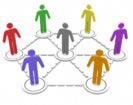Project Phase
A collection of logically-related project activities, usually culminating in the completion of a major deliverable. For example, start-up, planning, delivery and close. Project phases are mainly completed sequentially, but can overlap in some project situations. Phases can be subdivided into subphases and then components, this hierarchy is contained in the work breakdown structure. A project phase is a component of a project life cycle.
A collection of logically-related project activities, usually culminating in the completion of a major deliverable. For example, start-up, planning, delivery and close. Project phases are mainly completed sequentially, but can overlap in some project situations. Phases can be subdivided into subphases and then components, this hierarchy is contained in the work breakdown structure. A project phase is a component of a project life cycle.

- Determining what work needs to be completed
- Ensuring that all relevant stakeholders are consulted during the phase
- Facilitating an understanding of the interdependencies between phase deliverables
- Start-up or initiation: The phase in which the project is defined and authorized.
- Planning: The phase in which the project objectives, deliverables, schedule, and budget are developed.
- Delivery or execution: The phase in which the project plan is executed to complete the project deliverables.
- Closure: The phase in which the project is completed, archived, and lessons learned are captured.
- Initiating
- Planning
- Executing
- Monitoring and Controlling
- Closing
- Starting Up a Project
- Directing a Project (an overarching or umbrella phase)
- Initiating a Project
- Controlling a Stage
- Closing a Project
See all project management words
Methodology specific dictionaries / glossaries
- View the Agile Dictionary
- Managing Successful Programmes (MSP) Dictionary
- Prince 2 glossary of terms
- Full ITIL glossary of terms
- See also Risk Management Dictionary.

